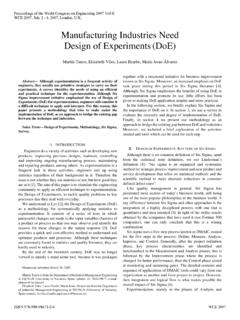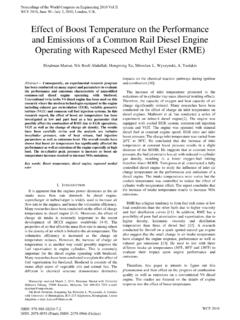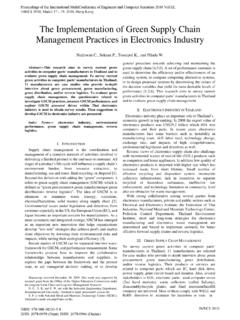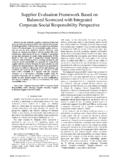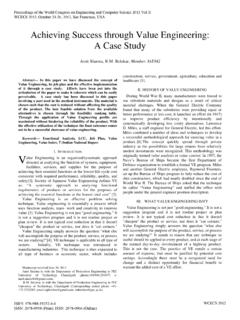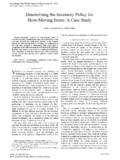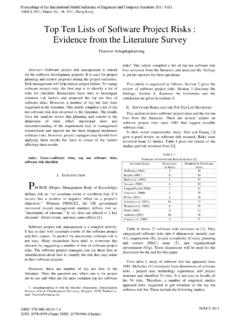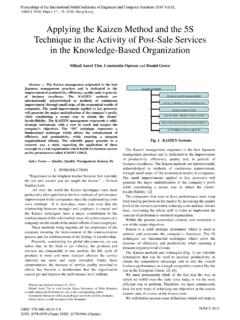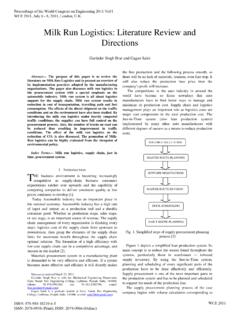Transcription of Detecting & Locating Leaks in Water Distribution ...
1 Abstract This paper focuses on the problem of Detecting and Locating the position of Water Leaks in Water Distribution Medium Density Polyethylene (MDPE) pipes using passive acoustic detection methods. A leaking Water pipe generates noise which depends primarily on Water pressure, pipe characteristics and the leak size and shape. This leak noise comprises vibration and acoustic signals, which can be detected using non-invasive accelerometers and invasive hydrophone sensors respectively. In current practise, a correlation technique is typically employed to detect, position and characterise these Water Leaks using the leak noise produced. This is proved to be very efficient for metallic pipes; however, the same is not true for plastic MDPE pipes where the attenuation rate with distance of the leak/source signal is very high, and the generated leak signals are of low frequency and narrow bandwidth.
2 In order to locate leak with good accuracy in MDPE pipes, correlation process relies on estimation of the speed of sound in Water /pipe and the time delay between leak signals measured at two locations across the pipes. The speed of sound can be calculated with good accuracy. However, the estimation of time delay depends upon the type, positioning of sensor and the processing of signals obtained; which is very difficult to do for MDPE pipes. Therefore in this paper, MDPE pipes are experimentally evaluated and it has been found that most of the leak signals for tested MDPE pipes lie in the frequency band of 20Hz to 250Hz, with the upper frequency limit changes with flow rate and leak characteristics. With these results, it is possible to achieve better performance of existing correlators by means of using appropriate filters and amplification. Index Terms Correlators, Leakage, Leak detection, Leak Location, Medium Density Polyethylene Pipes and Water Shortage.
3 I. Leaks AND THEIR IMPORTANCE Worldwide the shortage of drinking Water is a subject of increasing concern. This is because of the increasing demand for Water and decrease in Water supplies. A partial solution to this problem can be obtained by controlling the amount of Water loss in Distribution networks. Water loss mainly occurs due to leakage in Distribution networks. The volume of Manuscript received March 18, 2008. This work was supported in part by Severn Trent, UK, for Detecting and Locating Leaks in polyethylene pipes. Maninder Pal is research associate in the Department of Civil and Building Engineering, Loughborough University, Loughborough, LE11 3TU, UK (email: phone: + 44(0) 1509 228 745, fax: +44(0) 1509 223 945). N. Dixon is Professor of Geotechnical Engineering in the Department of Civil & Building Engineering, Loughborough University (email: J.)
4 Flint is Senior Lecturer in the Department of Electronic and Electrical Engineering, Loughborough University (email: leaking Water may constitute a significant portion of the Water fed into the networks. For example in 1991, International Water Supply Association (IWSA) reported a Water loss in between 20 to 30% of production, with leakage being the main component [1]. Leaks not only cause Water loss but also pose a risk to public health; economical losses due to the high cost of energy wasted on the treatment and pumping action of leaking Water [2], and risks to infrastructure such as building foundations and roads. Thus, Water leakage reduction from Distribution networks is a vital strategy in the improvement of sustainable use of Water , the most fundamental of our natural resources. Leak noise correlator (LNC) is the only credible option for Detecting and Locating Leaks in these pipes. The advantages of LNC s over other leak detection methods have been appreciated and accepted within the UK Water industry [3] and many other countries worldwide.)
5 In practice, LNC s are proved to be very efficient for metallic pipes. However, the same is not true for MDPE pipes where the attenuation rate with distance of the leak signal is very high and the generated leak signals are of low frequency and narrow bandwidth. Also in recent years, MDPE pipes are increasingly being used in Water industries because of their inherent advantages such as long life, ease of handling and low cost over metallic pipes. Therefore, this paper primarily focuses on understanding the characteristics of leak signals in MDPE pipes, which are used to optimize the variables of leak noise correlators to aid leak detection and location in MDPE pipes. II. LEAK DETECTION AND LOCATION IN MDPE PIPES A leaking Water pipe generates noise (sound and vibration) which is transmitted for long distances both inside the pipe and in the soil close to the leak [4, 5]. The term noise in this paper refers to a combination of leak signals and ambient noise due to various sources.
6 Acoustical devices such as hydrophones and mechanical vibrations measuring devices such as accelerometers are the most typical transducers used for measuring this noise. The signals from these transducers are normally analyzed using LNCs [4]. LNC equipment is based on the principle of cross-correlation of leak signals (Figure 1), obtained from the transducers/sensors connected to two known access points (such as fire hydrants) on either side of a leak and shows a distinct peak if a leak exists. To compute the leak location using correlation process, it will be assumed that the signals measured at the sensor positions 1 and 2 be x1(t) and x2(t) respectively. If the time taken by these leak signals to travel from leak position to sensor positions 1 and 2 be t1 and t2 Detecting & Locating Leaks in Water Distribution Polyethylene Pipes Maninder Pal, Neil Dixon and James Flint Proceedings of the World Congress on Engineering 2010 Vol II WCE 2010, June 30 - July 2, 2010, London, : 978-988-18210-7-2 ISSN: 2078-0958 (Print); ISSN: 2078-0966 (Online)WCE 2010 respectively, then the time delay (tdelay) between two measured signals (x1(t) and x2(t)) is related to location (L1) of the leak from sensor 1 by 2/)c D(Ldelay1-= (1) where c is the propagation speed of sound in Water pipe, L2 is the corresponding leak position from sensor 2 and D is the total distance (L1 + L2) between two sensors.
7 Propagation speed (c) depends upon pipe characteristics; however it can be estimated with good accuracy using various theoretical and practical methods. Time delay (tdelay) is estimated using cross-correlation of measured leak signals. The quality of this estimate depends upon the type, positioning of sensors and the processing of signals obtained. Cross-correlation of two measured leak signals x1(t) and x2(t) is usually done in the frequency domain [6] for ease of calculations, by taking the inverse Fourier transform (Figure 2) of the product of complex conjugate of Fourier transform of measured leak signal x1(t) with the Fourier transform of leak signal x2(t) as dfefXfXTfj -=tpt22*1xx)()(1)(R 21 (2) where * denotes the complex conjugate. In practise, due to the noise and attenuation of leak signals, the measured signals and their correlation function fluctuates.
8 These fluctuations can sometimes be very large, making it difficult to identify the correlation peak responsible for leak signals. Therefore, the cross-correlation function ()(21xxtr) is expressed in normalized (dimensionless) form on the scale of -1 to 1, as: (0) (0) )( )(22112121xxxxxxxxRRRttr= (3) where (0) 11xxR and (0) 22xxR are the values of auto-correlation functions )( 11xxtR and )( 22xxtR at t=0. In equation 2, the correlation function depends upon the frequency of input signals; thus an inappropriate filter range may lead to an error or false peaks. Therefore in current paper, the frequency and phase characteristics of leak signals in MDPE pipes are evaluated using experimental studies; which help to achieve better performance of existing LNC s in MDPE pipes by means of using appropriate filters and amplification.
9 Figure1: Basic principle of cross-correlation for leak detection. Figure 2: Schematic diagram of implementing cross-correlation of leak signals in frequency domain. III. EXPERIMENTAL STUDIES A. Test Set Up The pilot study measurements were initially carried out on MDPE pipes in air under controlled laboratory conditions and are detailed by Pal et al. in [6]. This decision was made on the basis of studies done by Muggleton et al. [7], in which the effect of surrounding medium in buried plastic pipes on wavespeed was found to be relatively small. However in practise, the Water pipes are buried; thus, to determine the effectiveness of the proposed cross-correlation method, a series of tests were conducted on buried MDPE pipe network at Severn Trent (ST) lake House test site located in Anstey, Leicestershire, UK. The layout of the buried pipe network at lake House is shown in Figure 3.
10 The 90mm diameter MDPE main pipe (Figure 3) was long with FH2 Type Proceedings of the World Congress on Engineering 2010 Vol II WCE 2010, June 30 - July 2, 2010, London, : 978-988-18210-7-2 ISSN: 2078-0958 (Print); ISSN: 2078-0966 (Online)WCE 2010 Underground Fire Hydrant (DN80, PN16 Pressure Rating and BS 750 Type 2) connected at each end using flange fittings and a rubber gasket in between. Three 25mm diameter MDPE service pipes (SP1, SP2 and SP3) were connected to the main pipe at , and respectively from the hydrant 1 position using electro-fused fittings and a boundary box. The other end of these service pipes were closed with a stop cap. A chamber measuring long and wide was made along the length of main pipe and a distance of from hydrant 1 position; to simulate Leaks in a section of 90mm diameter MDPE pipe measuring approximately in length. This smaller section of pipe can be connected to the main pipe using couplers and/or flange plate couplings (BS404).
